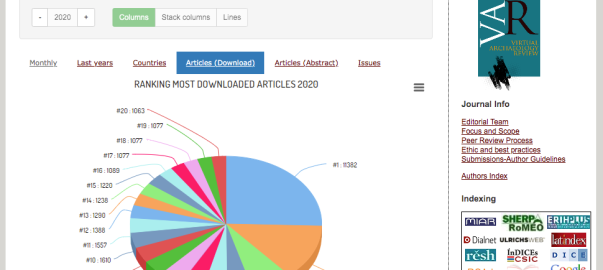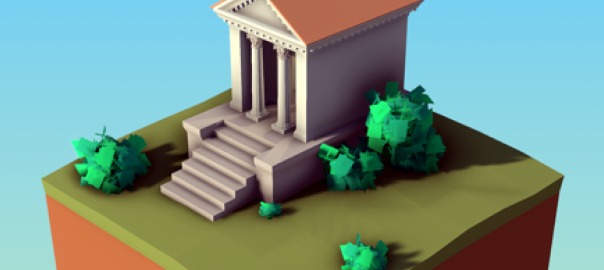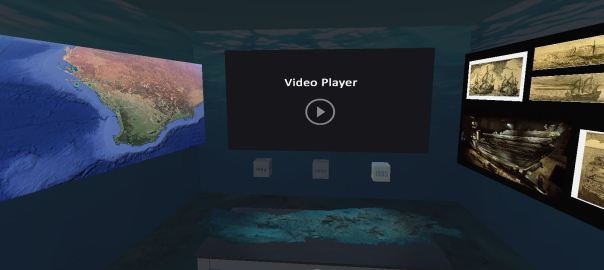Virtual Archaeology Review declared my and Dr Rahaman’s 2020 paper “Survey of #3D digital heritage repositories and platforms” their paper of the year.

Virtual Archaeology Review declared my and Dr Rahaman’s 2020 paper “Survey of #3D digital heritage repositories and platforms” their paper of the year.
I’ve been asked advice on virtual heritage-related journals.
I’d suggest (and this is not a comprehensive list):
I am no longer a fulltime professional academic (and not on the editorial boards of the above) so caveat emptor.
New article
Hafizur Rahaman, Michelle Johnston & Erik Champion (2021). Audio-augmented arboreality: wildflowers and language, Digital Creativity, DOI: 10.1080/14626268.2020.1868536 free for first 50 people:
Before colonization, there were over 250 languages spoken in Australia. Today only thirteen Indigenous languages are still being taught to children). Language has an important part to play in cultural maintenance and ‘closing the gap’ in terms of First Peoples’ cultural heritage, identity, and sense of belonging. In this work, we aim to develop an engaging and easy way to teach and learn the local Indigenous names of wildflowers using a mobile device. This paper presents the development of a phone application that runs on a local machine, recognizes local wildflowers through its camera, and plays associated sounds and displays associated text in the Noongar language. The prototype mobile application has been developed with MobileNets model on the TensorFlow platform. The dataset is derived from Google searches, while the sound files are generated from label text by running an apple script. UI and interactivity have been developed by using Vuforia and the Unity game engine. Finally, the Android Studio is used to deploy the app. At this point in time, the prototype can only recognize ten local flowers, with 85%∼99% of accuracy. We are working with a larger dataset towards developing the full application.

I am impressed that the Virtual Archaeology Review Journal (@VARjournal) has a stats page with % comparing views to downloads and abstracts listed (and a 3D -model- filter!) It can help authors check their abstract is on target (i.e. catchy). Our (with Dr Hafizur Rahaman @hafi2018) 2020 article Survey of 3D digital heritage repositories and platforms was 6th most downloaded article (3rd for 2020). NB had trouble viewing, had to refresh several times.
CHAMPION, Erik; RAHAMAN, Hafizur. Survey of 3D digital heritage repositories and platforms. Virtual Archaeology Review, [S.l.], v. 11, n. 23, p. 1-15, July 2020. ISSN 1989-9947. Available at: <https://polipapers.upv.es/index.php/var/article/view/13226>. Date accessed: 04 Jan. 2021. doi:https://doi.org/10.4995/var.2020.13226.
LE210100021 — The University of Melbourne
Australian Cultural Data Engine for Research, Industry and Government. The project aims to develop an Australian Cultural Data Engine (ACD-Engine), which will be an open software engineering facility that interacts with leading existing cultural databases in architecture, visual and performing arts, humanities, and heritage to build a bridge to information and social sciences. The ACD-Engine will unify and expand these disparate and previously unconnected systems to allow advanced analysis techniques to be performed. It will deliver innovative and searchable formats that ensure interoperability, improved search, interactive design and interpretation aids that will benefit the policy and planning for national and international alignments between researchers, industry and government.


Was one of two book covers possible and I think due to some email confusion they didn’t choose my preferred cover but I really appreciate permission by Dr Anthony Masinton to use his rendered image. The publisher of Rethinking Virtual Places will be Indiana University Press, via their Spatial Humanities Series.
I’m stuck at a new home (for several months, possibly) training a dog from a refuge home, so will be missing intellectual stimulation. I’m examining a PhD thesis application this week but would consider one or more in January or February. I am generally asked to examine theses in architecture, heritage (particularly digital heritage), serious games/game-based learning, machinima, virtual worlds (especially virtual places), museum studies or virtual environments more generally.
On cleaning up my old email I found an old short paper suggestion to a Digital Humanities Conference Workshop, in 2013?! Not even sure they replied, cant remember! I think some of the ideas were used in the Critical Gaming book that Routledge published in 2015.
This paper is a theoretical attempt to outline types of violence in computer games, and develop a short framework for types of interaction in virtual heritage projects. It will then attempt to sketch out both the typical factors leading to violence in digital heritage projects and reasons involving their widespread occurrence. Finally it will suggest alternatives to violent interaction when applied to digital heritage projects.
Yesterday I signed an agreement to be an adjunct Professor of or at Curtin University, today that changed to accepting the title of Emeritus Professor. Hard to keep up! The requirement is:
has demonstrated distinguished service and commitment to the University over a period of normally five years of continuous service prior to retirement.
So I am not retired, just ‘retired’ from Curtin University. I will now look for employment at an organization interested in digital-based learning, digital heritage, serious games, virtual tourism. I was told these are not strategic areas for Curtin but I am sure they are growth areas for others.
And it gets confusing, I am an honorary research fellow at UWA and honorary research professor at ANU. So probably I’ll just go by my given name for most things. I’m not old enough or rich enough to be retired!
Champion, E. (2020). Culturally Significant Presence in Single-player Computer Games. Journal on Computing and Cultural Heritage, 13(4). doi:10.1145/3414831. https://dl.acm.org/doi/10.1145/3414831
Cultural presence is a term used to explain and evaluate cultural learning in virtual heritage projects but is less frequently used for video games. Given the increasing importance of video games to cultural heritage, this article investigates explanations of cultural presence that could be communicated by games, especially concerning UNESCO and ICOMOS definitions of cultural significance. The aim is to determine if cultural presence can be communicated via video games and across a range of game genres.
Observations derived from game prototyping workshops for history and heritage aided the development of a teachable list of desirable game elements. To distinguish itself from the vagueness surrounding theories of cultural presence, a theory of culturally significant presence is proposed. Culturally significant presence requires three components: culturally significant artifacts and practices; an overarching framework of a singular, identifiable cultural viewpoint; and awareness by the participant of both the culturally significant and the overarching cultural framework and perspective (which gives sites, artifacts, and practices their cultural significance and relational value).
As awareness of cultural presence requires time for reflection, single-player games were chosen that were not completely dependent on time-based challenges. Another criterion was cultural heritage content: They must simulate aspects of heritage and history, communicate a specific cultural framework, or explore and reconstruct a past culture. Four games were chosen that simulate a culture, explain archaeological methods, portray indigenous intangible heritage, or explain historical-based ecosystems of the past based on educational guidelines. The games are Assassin’s Creed: Origins; Heaven’s Vault; Never Alone; and a Ph.D. project: Saxon. Their genres could be described as first-person shooter/open world/virtual tour; dialogue-based puzzle game; 2D platform game; and turn-based strategy game.
The aim is not to evaluate the entire range of interactive virtual environments and games, but to examine the applicability and relevance of this new theory and to ascertain whether the four games provided useful feedback on the concept and usefulness of culturally significant presence. A more clearly demarcated theory may not only help focus evaluation studies but also encourage game developers to modify or allow modification of commercial games for classroom teaching of digital heritage.

oh and examining PhD theses…
Awaiting news of European and Australian grant applications.
November 25, 2020 Categorised: News
“The Australian Research Data Commons (ARDC) is excited to announce a new investment of $9.7 million, with $15.5 million in co-investments from collaborating organisations, in 16 new platform projects.”
Time-Layered Cultural Map of Australia
https://ardc.edu.au/news/new-data-projects-will-help-transform-australian-research/
Time-Layered Cultural Map of Australia 2.0 (https://doi.org/10.47486/PL069): The Time-Layered Cultural Map of Australia platform (TLCMap) is a software ecosystem meeting the digital mapping needs of humanities and social science researchers. The current TLCMap is unique in offering the means to visualise and interrogate historical and cultural data organised through spatio-temporal coordinates. The TLC Map 2.0 project will enhance the current platform through improved connectivity to relevant external platforms and archives and to national place-name authorities. It will also add new features in the handling of spatial and temporal data.
I presented our contribution to TLC 1.0 this month at EuroMed 2020. Slides are here:

25 November 2020 (virtual invited talk to Uppsala University Sweden)
From virtual museums to virtual worlds, the word “virtual” is both a popular and a vague term. Although popularised by computer science and science fiction, the field of virtuality is also of interest to the humanities, and especially to historians and heritage experts. Yet there are few courses in the area, and few accessible examples of successful virtual humanities projects. Why? And what can be done?
public seminar series for the research network Digital Humanities Uppsala:
25 November 2020 10.15-12 Swedish time (GMT+1)
The seminar will be held on Zoom. Link: https://uu-se.zoom.us/j/66954058750

Have sent out a proposal to people who use the above game series in the classroom and/or write about it. Have spoken to Ubisoft about this so possibly can work with historians and archaeologists working with Ubisoft as well.
Authors: Will be an ongoing negotiation process, from abstract/title to publisher and external reviews (depending on the publisher).
Audience: Would be useful if it can be used in a classroom (perhaps university-level undergraduate) but with some thoughtful articles.
Content: How Assassin’s Creed evolved in terms of history and simulation, how it is seen (inside and outside Ubisoft) in terms of its potential in education, heritage and tourism. Indeed a book I am co-editing has a chapter on Assassin’s Creed and screen tourism and I have been tasked to write it! But for this project, I would be very happy to get a conversation going between game designers, consultants, historians, academics and game design teachers.
Focus: How could Assassin’s Creed change or create more flexibility for use and reuse and input from these sectors? How do the scholars and designers see new ways of using games to learn about aspects of history that would be of interest to Ubisoft in particular and game companies in general?
Language: I think I should find a co-editor and possibly French-speaking, would it make sense to have French language chapters and or a French version?
Publisher: I don’t have funds for open access publisher fees but ideally it would be (at least in part) free on the web so it could easily be picked up by classrooms. Update: have received some interest already.
Timing: We are looking at a mid to late 2021 final submission by authors so the book might have to appear in 2022.
Professor Jeremy Huggett has published an article drawn, I understand, from a talk he gave at Virtual Heritage Ireland in 2015.
It quotes 2 or 3 of my earlier publications and I am not sure on certain points if he agrees or disagrees with me/Laia Tost so I will have to read it more slowly later, but if you are interested in my publications he is writing on a similar topic and you might find it thought-provoking.
Hugget, J. (2020). Studies in Digital Heritage. Virtually Real or Really Virtual: Towards a Heritage Metaverse, 4(1).
When are titles misleading? When they say they will direct you towards something but are actually sceptical that there is a direction at all.
Huggett (p.9):
Although we have made tremendous strides forward in the intervening twenty-two years in terms of data capture, modelling, and presentation, I would suggest that we are more often than not still at the stage of generating ingenious, largely passive imagery designed to be viewed and consumed – and this is equally as true of current consumer virtual reality headsets as it is of more traditional three-dimensional heritage representations. We have yet to fully rise to the challenge and potential offered by virtual reality, and consequently virtual heritage has yet to realize its potential for engaging with and understanding the past.
I’d point the reader to my book Rethinking Virtual Places but Indiana University Press are still printing it.
Perhaps, then, this article, which tries to explain why and how virtual heritage can be entertaining:
Champion, E. (2015). Entertaining The Similarities And Distinctions Between Serious Games and Virtual Heritage Projects. Entertainment Computing 14. DOI: 10.1016/j.entcom.2015.11.003 or researchgate

My slides for the below EuroMed2020 paper presentation yesterday are on slideshare. We were told the publications will be available at latest in January 2021.
Time-Layered Gamic Interaction with a Virtual Museum Template
Erik Champion, Rebecca Kerr, Hafizur Rahaman and David McMeekin
Abstract. This paper discusses a simplified workflow and interactive learning opportunities for exporting map and location data using a free tool, Recogito into a Unity game environment with a simple virtual museum room template. The aim was to create simple interactive virtual museums for humanities scholars and students with a minimum of programming or gaming experience, while still allowing for interesting time-related tasks. The virtual environment template was created for the Oculus Quest and controllers but can be easily adapted to other head-mounted displays or run on a normal desktop computer. Although this is an experimental design, it is part of a project to increase the use of time-layered cultural data and related mapping technology by humanities researchers.

My presentation slides for virtual The Interactive Pasts Conference Online 2 (TIPC2), (held 5-6 November, notionally, at Leiden) are on slideshare.
The twitch stream for the conference is at https://www.twitch.tv/valuefnd (my talk from yesterday is on there somewhere).
This paper explores Assassin’s Creed: Odyssey as a way to explore idyllic historic landscapes and heritage sites with some degree of questing and simulated danger. It applies Assassin’s Creed: Odyssey in two ways, as discovery tour option mode and as a metaphor to explore in more general and speculative terms how questing and historical dilemmas and conflicts could be incorporated into both fan tourism and cultural/historical tourism (Politopoulos, Mol, Boom, & Ariese, 2019).
Keza MacDonald views Assassin’s Creed as a virtual museum, Ubisoft regards it as the recovery of lost worlds: “ “We give access to a world that was lost” said Jean Guesdon (MacDonald, 2018). “Discovery Tour will allow a lot of our players to revisit this world with their kids, or even their parents.”
Origins’ Discovery Tour mode “promises” educational enlightenment (Thier, 2018; Walker, 2018); Odyssey’s additional Story Creator Mode (Zagalo, 2020) adds personalized quests. Beyond the polaroid fun of sharing landscape selfies with other players and ancient history voyeurs across the Internet, there is also the prospect of “Video game–induced tourism: a new frontier for destination marketers” (Dubois & Gibbs, 2018). Plus physical location VR games. Game company Ubisoft created escape game VR and virtual tours inside physical exhibitions such as Assassin’s Creed VR – Temple of Anubis (Gamasutra Staff, 2019). Is there a market for historical playgrounds as virtual tourism?

The paper “Time-Layered Gamic Interaction with a Virtual Museum Template” by Erik Champion, Rebecca Kerr, Hafizur Rahaman and David McMeekin will be presented virtually at EuroMed 2020 Conference next week. The project is part of the ARC funded project Time Layered Culture Map (tlc). Registration is free.
Abstract. This paper discusses a simplified workflow and interactive learning opportunities for exporting map and location data using a free tool, Recogito into a Unity game environment with a simple virtual museum room template. The aim was to create simple interactive virtual museums for humanities scholars and students with a minimum of programming or gaming experience, while still allowing for interesting time-related tasks. The virtual environment template was created for the Oculus Quest and controllers but can be easily adapted to other head-mounted displays or run on a normal desktop computer. Although this is an experimental design, it is part of a project to increase the use of time-layered cultural data and related mapping technology by humanities researchers.

Just received a big compliment from a US academic/architect I respect on my (Nordic) organic architecture book, Organic Design in Twentieth-Century Nordic Architecture. Chuffed. The foreword is by Professor Adrian Carter, Bond University, inaugural Director of the Utzon centre, Aalborg, Denmark.
Ideas that led to the 1991-3 thesis that led to this 2019 book actually helped me in terms of thinking about place in virtual environments
Sorry I have not had time to insert the 150 images or so into the free preprint book version on research gate: https://researchgate.net/publication/331240106_Organic_Design_in_Twentieth-Century_Nordic_Architecture

My publisher, Indiana University Press, has asked me to name academics who would like to be alerted when my next book, Rethinking Virtual Places, is out in case they might consider it for course reading lists. Let me know! (it will be in the IUP Spatial Humanties series).
| 1-A Potted History of Virtual Reality |
| 2-Dead, Dying, Failed Worlds |
| 3-Architecture: Places Without People |
| 4-Theories of Place & Cyberspace |
| 5-Rats & Goosebumps-Mind, Body & Embodiment |
| 6-Games are not Interactive Places |
| 7-Do Serious Gamers Learn From Place? |
| 8-Cultural Places |
| 9-Evaluating Sense of Place, Virtual Places & Virtual Worlds |
| 10-Place-Making Interfaces & Platforms |
| 11-Conclusion |